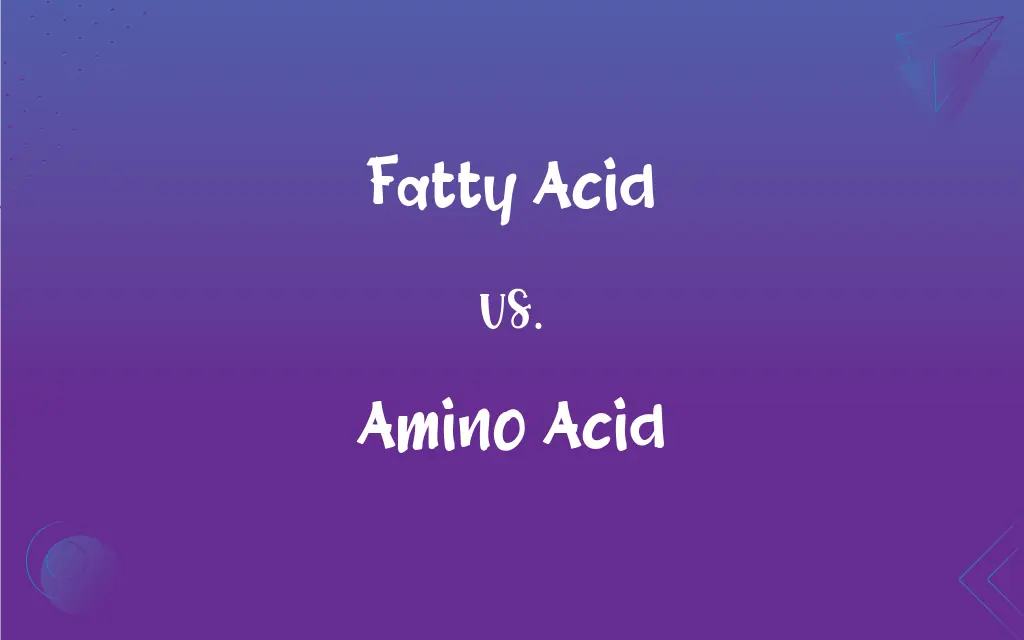Fatty Acid vs. Amino Acid: What's the Difference?
Edited by Aimie Carlson || By Janet White || Published on January 31, 2024
Fatty acids are long hydrocarbon chains important for energy storage, whereas amino acids are organic compounds forming proteins, vital for body functions.

Key Differences
Fatty acids primarily function as a significant energy source stored in the form of triglycerides. In contrast, amino acids are the building blocks of proteins, essential for various bodily functions, including tissue repair and enzyme production.
Structurally, fatty acids consist of a carboxylic acid group attached to a long hydrocarbon chain, which can be saturated or unsaturated. Amino acids, on the other hand, are composed of an amino group, a carboxyl group, and a unique side chain, determining their individual characteristics.
In terms of solubility, fatty acids are generally hydrophobic due to their long hydrocarbon tail, making them insoluble in water. Amino acids exhibit varying degrees of solubility in water, influenced by their side chains, allowing them to play diverse roles in cellular processes.
Fatty acids are crucial for cell membrane structure and signaling molecules. Amino acids contribute to cellular structure through proteins and play a pivotal role in metabolic pathways, neurotransmitter synthesis, and immune responses.
Dietary sources of fatty acids include fats and oils from plants and animals. Amino acids are obtained from protein-rich foods like meat, dairy, and legumes, with essential amino acids needing to be sourced from the diet.
ADVERTISEMENT
Comparison Chart
Basic Structure
Carboxylic acid group with a hydrocarbon chain
Amino group, carboxyl group, and a unique side chain
Solubility
Generally hydrophobic, insoluble in water
Varying solubility, influenced by side chains
Primary Function
Energy storage, cell membrane structure
Building proteins, metabolic processes
Dietary Sources
Fats and oils from plants and animals
Protein-rich foods like meat, dairy, legumes
Variability
Can be saturated or unsaturated
20 standard types, each with a unique side chain
ADVERTISEMENT
Fatty Acid and Amino Acid Definitions
Fatty Acid
In nutrition, fatty acids are vital for absorbing fat-soluble vitamins.
Dietary fatty acids aid in the absorption of vitamin D.
Amino Acid
An amino acid is an organic compound with both an amino group and a carboxyl group.
Tryptophan, an amino acid, is essential for serotonin production.
Fatty Acid
Fatty acids serve as signaling molecules and precursors to bioactive lipids.
The fatty acids in cell membranes play a role in intracellular communication.
Amino Acid
There are twenty standard amino acids, each with a distinct side chain.
Leucine, an amino acid, is crucial for muscle protein synthesis.
Fatty Acid
A fatty acid is an organic compound with a hydrocarbon chain and a terminal carboxyl group.
Olive oil is rich in oleic acid, a type of monounsaturated fatty acid.
Amino Acid
Essential amino acids must be obtained through diet, as the body cannot synthesize them.
Lysine, an essential amino acid, is found in meat and legumes.
Fatty Acid
Fatty acids are key components of lipids, crucial for energy storage and cell structure.
The fatty acids in fish oil are beneficial for cardiovascular health.
Amino Acid
Amino acids are the building blocks of proteins, linking in chains to form peptides.
Collagen, a protein in skin, is made from specific amino acids.
Fatty Acid
These acids can be saturated or unsaturated, influencing their physical properties.
Butter, high in saturated fatty acids, is solid at room temperature.
Amino Acid
Amino acids play roles in metabolism, neurotransmitter synthesis, and immune response.
The amino acid arginine is involved in wound healing and immune function.
FAQs
How do fatty acids differ in structure from amino acids?
Fatty acids have a hydrocarbon chain and a carboxyl group, while amino acids have an amino group, a carboxyl group, and a side chain.
What is the role of amino acids in the body?
They build proteins, vital for tissue repair, enzyme production, and metabolic processes.
What are fatty acids?
Organic compounds with a hydrocarbon chain and a carboxyl group, important for energy storage and cell structure.
What are amino acids?
Organic compounds that form proteins, crucial for various body functions.
How many amino acids are there?
Twenty standard amino acids, each with a unique side chain.
What is the role of fatty acids in the body?
They serve as energy storage, cell membrane components, and signaling molecules.
Can the body produce all necessary amino acids?
No, essential amino acids must be obtained from the diet.
Why are omega-3 fatty acids important?
They are polyunsaturated fatty acids beneficial for heart health and inflammation reduction.
Are all fatty acids the same?
No, they vary in chain length and can be saturated or unsaturated.
How do trans fats differ from other fatty acids?
Trans fats are unsaturated fatty acids with a specific bond configuration, often produced industrially and associated with health risks.
Can amino acids be used for energy?
Yes, they can be metabolized for energy, especially during prolonged exercise or starvation.
Are there essential amino acids?
Yes, several amino acids are essential and must be sourced from food.
Can fatty acids affect cholesterol levels?
Yes, saturated and trans fatty acids can raise LDL (bad) cholesterol, while unsaturated fats can improve cholesterol profiles.
What are the sources of omega-3 fatty acids?
Fish, flaxseeds, and walnuts are rich in omega-3 fatty acids.
Are amino acids important for athletes?
Absolutely, as they are crucial for muscle repair and growth.
Do amino acids affect brain function?
Yes, some amino acids are precursors to neurotransmitters, affecting mood and cognitive function.
Do fatty acids have a role in inflammation?
Yes, certain fatty acids can either promote or reduce inflammation.
What are essential fatty acids?
Fatty acids that the body cannot synthesize and must be obtained through diet, like omega-3 and omega-6.
What is the difference between complete and incomplete proteins?
Complete proteins contain all essential amino acids, while incomplete proteins lack one or more of these.
Can vegetarians get all essential amino acids?
Yes, by consuming a variety of plant-based proteins.
About Author
Written by
Janet WhiteJanet White has been an esteemed writer and blogger for Difference Wiki. Holding a Master's degree in Science and Medical Journalism from the prestigious Boston University, she has consistently demonstrated her expertise and passion for her field. When she's not immersed in her work, Janet relishes her time exercising, delving into a good book, and cherishing moments with friends and family.
Edited by
Aimie CarlsonAimie Carlson, holding a master's degree in English literature, is a fervent English language enthusiast. She lends her writing talents to Difference Wiki, a prominent website that specializes in comparisons, offering readers insightful analyses that both captivate and inform.







































































